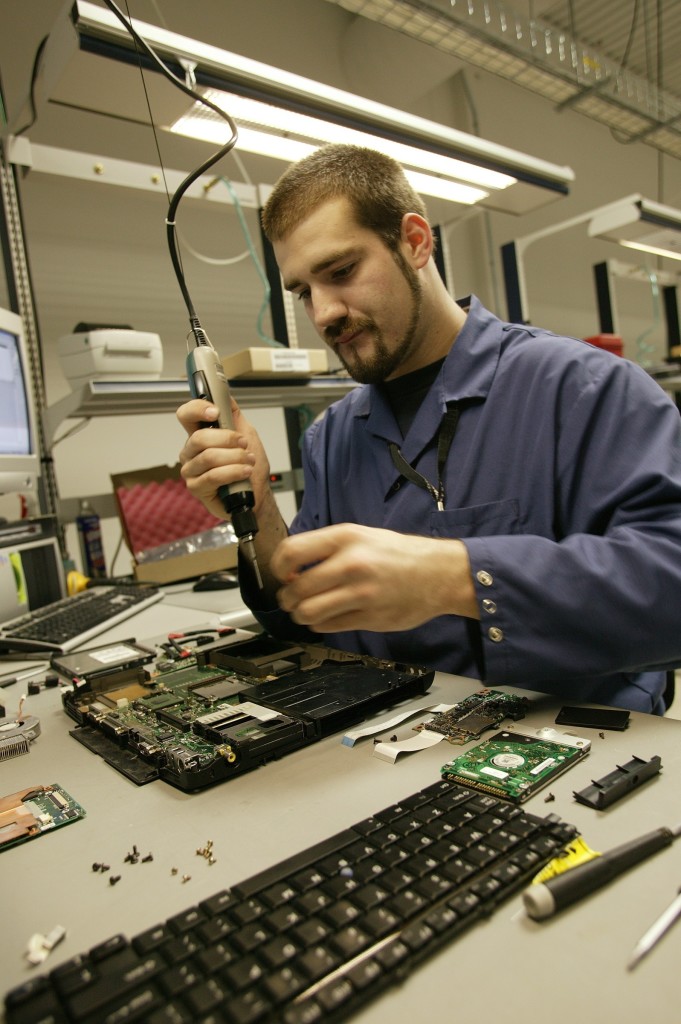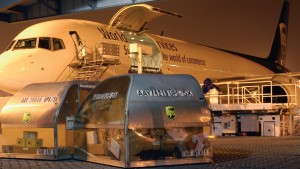UPS Revamps Supply Chain Service Offering
Louisville, Kentucky USA
April 8, 2008
By
Richard Armstrong
UPS Personnel Present:
David Bowles, President Global Logistics & Distribution
Brad Mitchell, COO Global Logistics & Distribution
Charlie Covert, VP Global Solutions High Tech
Bill Hook, VP Global Strategy & Healthcare
Jeff Jones, VP Technology Services
John Sutthoff, VP Global Marketing & Supply Chain Strategy
Marvin Rosenzweig, VP Business Development
Jason Vaughn, VP Distribution Operations
Jerry Kohnke, VP U.S. Distribution
Harvey Rickles, Director of Marketing – Distribution
Phil Corwin, Director of Marketing – Post Sales Services
Robyn Brunscher, Business Development Manager – Americas
Susan Rosenberg, Manager Corporate Public Relations
Rich Shaver, Director of Operations – Healthcare
Overview
We recently spent two days at the UPS Supply Chain Solutions Campus in Louisville, KY. Here are our observations:
UPS has modified its strategic plan for its contract logistics division to target three industry verticals: Healthcare, High-Tech and Retail/Consumer Goods.
Solutions are focused according to vertical with high-tech skewed to service parts distribution and repair/returns, with added value to programs coordinated globally. Healthcare leverages assets for finished goods distribution and returns within facilities designed for regulatory compliance and temperature sensitive needs. Both are concentrated at the Louisville campus to take advantage of a central U.S. location for high-value inventory and adjacency to the UPS Worldport package and air freight hub for end-of-runway operations. Retail/CPG (consumer packaged goods) finished goods distribution and returns are clustered elsewhere on strategic campuses or distribution centers (DCs) at Hebron, KY; Mira Loma, CA; Harrisburg, PA; Chicago, IL; Dallas/Fort Worth, TX; Reno, NV; Atlanta, GA; Seattle, WA and Northern New Jersey.
Some major customers taking advantage of the contract logistics services on the Louisville campus are Sprint, Nikon, Toshiba, IKON Office Solutions, Philips Healthcare, Abbott Diabetes Care, Dr. Reddy’s Laboratories, Corning Life Sciences, and ConvaTec, a unit of Bristol-Myers Squibb.
Here are some examples of UPS solutions:
For Philips Healthcare, UPS executes global supply chain management from its DCs in Louisville, Singapore and the Netherlands. This distribution and service parts solution manages product flow to stocking locations and returns from field technicians. UPS has expanded both inbound/outbound global transportation services and has integrated the Philips global enterprise resource planning (ERP) platform and UPS logistics management systems to provide global visibility of parts from order entry through customer delivery and returns management for post-sales service.
For Sprint, UPS has set up 500,000 sq. ft. of fulfillment space in a new Louisville facility as collaboration and business activity have grown consistently over the last three years. After its purchase of Nextel, Sprint brought in Richard Motilal, an experienced logistician to resolve supply chain problems. He quickly got oriented and worked with his team to develop a request for proposal (RFP) to address the vision of efficient fulfillment and reverse logistics operations. UPS won the expanded business and has reduced the number of DCs from 19 to three. Sprint has achieved greater flexibility, a customized solution, a well executed and constantly improving supply chain plan plus cost savings. In addition, UPS covers volume peaks and valleys well. Motilal notes that it is important for partnerships to be formed and recommends that third-party logistics provider (3PL) users not try to “micromanage”.
The expanded Sprint operation includes a highly automated UPS fulfillment system utilizing four pick modules which are three layers high and over 200 feet long. Capacity is available to handle 65,000 orders a day. UPS also handles Sprint’s return business including Level 1-3 repairs.
For IKON, UPS runs a piece-pick and order consolidation operation. It has brought together 19 previous distribution locations into one. Orders are received for field technicians and shipped to UPS Store locations for pickup. The UPS redesigned parts supply chain has lowered IKON’s transportation costs over 70% for ground transportation and 51% for air transportation. Orders received before 6 P.M. are shipped for next day delivery.

UPS SCS Laptop Repair
Toshiba also leverages The UPS Store network for a program to offer customers next day and two day service via UPS for laptop repairs and warranty service. Within the multi-client warehouse, UPS operates a DC for parts to service technicians and authorized service locations as well as a retail channel returns program and call center. The laptop repair operation for Toshiba is emblematic of UPS engineering, having created L-shaped stations where each technician can run diagnostics and repair up to four laptops, all within a constant temperature environment. Electronic Static Discharge flooring and wrist straps are utilized to keep the operation static free.
UPS has more than 3 million sq. ft. of dedicated space for healthcare logistics in North America with certified licenses from the FDA (Food and Drug Administration) and DEA (Drug Enforcement Administration) and is compliant to the PDMA (Prescription Drug Marketing Act) and cGMP (current Good Manufacturing Practice) standards. UPS is also certified as a Verified Accredited Wholesale Distributor. The Louisville campus features a primary 575,000 sq. ft. building and a portion of an 822,000 sq. ft. building dedicated to healthcare. The facilities have full backup power generation to ensure temperature is maintained during power disruptions.
UPS SCS Laptop Repair
These facilities include temperature (20° Celsius) and humidity (50%) controls as well as dedicated cooler space (2-20° Celsius) and a large freezer room. Processes within the building are established and revised regularly by UPS and its partners. Shipments are made to about 100 countries from this facility. (The UPS Worldport air express hub is two miles away.) The primary Healthcare building has 40 foot ceilings and narrow aisles with six-high racking. UPS IT visibility and system linkages manage expiration and lot number controls. UPS works with its clients to provide e-pedigree compliance as markets require.

UPS 757 at Worldport dock
The examples quoted above show the new UPS contract logistics focus. The solutions being provided require sophisticated global IT capability, and UPS is a leader in this space. Jeff Jones, vice president of technology services, is one of the best in third-party logistics. Just as importantly, UPS has gotten much better at applying its famous engineering, design and yield management to this business.
As president of global logistics and distribution David Bowles points out, “UPS is the best supply chain solution, not the cheap alternative.” Bowles and his team are dedicated to high class, quality solutions. They are one of the few operations that can provide integrated, multifunctional, truly global solutions.
Additional Information
As part of our visit to the UPS Louisville campus, we picked up several interesting facts indicative of UPS scale as a global supply chain manager.
- UPS invests $1 billion a year in IT.
- UPS processes 4.5 million U.S. Customs brokerage entries per year (2007).
- UPS has 81,000 delivery information acquisition devices (DIAD’s) in use every day.
- Mahwah, NJ has a Tier 4 (highest level of IT) system available. This classification is the first Tier 4 designation ever given.
- The Louisville campus includes a foreign trade zone.
- UPS has nearly 21 million sq. ft. of focused distribution space globally and another nearly 18 million sq. ft. of forwarding and consolidation locations.
| Location | Square Feet (In Millions) |
|---|---|
| U.S. | 10.4 |
| Canada | 3.6 |
| Mexico | .360 |
| EMEA | 3.6 |
| Asia pacific | 2.9 |
| China/Hong Kong | 1.3 |
| Singapore | .770 |
| India | .043 |
- China and India are strong growth markets for facilities and services.
- UPS has engineered its processes and information systems linkage for efficient implementation. A standardized 40-step process is being patented. UPS effectively uses applications to different warehouse management systems (WMS) based on industry sector applications linked to its own SPLUS platform for service parts distribution and returns.
UPS has approximately 900 3PL contracts. - UPS has 24,000 employees in Kentucky and is that state’s largest private employer. The Louisville supply chain campus has approximately 4,000 employees. The multi-client campus allows flexibility to shift workers on short notice to manage peaks and valleys of work. This facilitates seasonal or day-specific fulfillment requirements, customer promotions or highly competitive speed-to-market activities for a new product launch such as a generic drug just receiving FDA approval.
- The 11 P.M. – 4 A.M. UPS Worldport air express sort hires hundreds of college students under a special Louisville Metro College program. UPS pays their tuition and other college expenses.
- Part-time hub workers are also eligible for medical benefits.
- UPS SCS now feeds $2 billion a year to UPS small package.
- 86% of world healthcare spend is in North America, Japan and Europe.
- Mark Hone, global distribution and transportation manager for Abbott Diabetes Care said that the UPS operations for Abbott run, “Smooth as silk.” He indicated that Abbott’s merger with TheraSence drove formation of the partnership.
- Bill Gardner of Nikon said that the coming of the new technology of digital cameras drove Nikon’s outsourcing to UPS. Using Louisville as a central DC from assorted inbound international air freight movements from Nikon manufacturing, UPS does extensive kitting for Nikon and handles its significant order variations corresponding to unique retailer promotions.
- High-Tech customers generate about ten times more air freight revenue than ocean freight revenue.
- UPS recently tripled the number of express air freight lanes to realign its international network of UPS Airlines “browntails” and purchased space as a forwarder on commercial carriers. UPS manages over 1 billion kilos of air freight annually.
- Fortune 500 customers initially spread UPS globally, but growing medium-sized customers fill out distribution capacity and increasing multi-modal transportation strategies for air and ocean freight services as well as global small package express and less-than-truckload transportation.
- The UPS business model and IT are robust and highly reputable.
Final Comment
UPS SCS looks like it is really getting its act together. It should remain profitable going forward. Net revenues are $5.9 billion ($1.6 billion in contract logistics and $4.3 billion in NVOCC/freight forwarding/customs brokerage). There is a lot of talent and innovation developing and executing UPS supply chain strategies; some of it by guys who never drove a brown truck.
Sources: A&A Primary Research, http://www.ups-scs.com/


